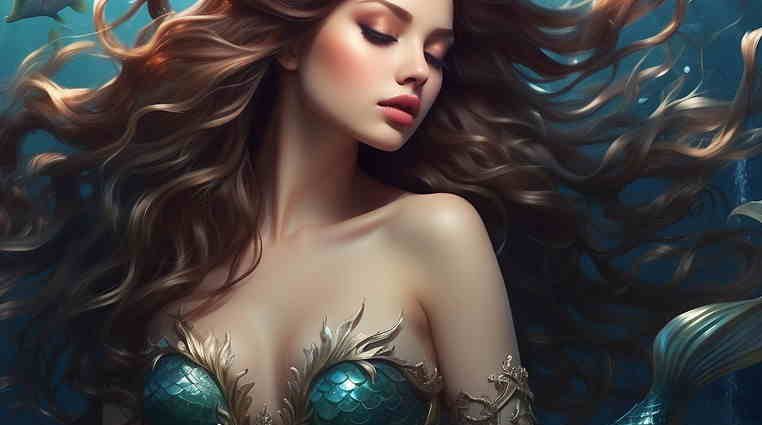“The Little mermaid0,” originally penned by Hans Christian Andersen in 1837, has transcended its origins as a Danish fairy tale to become a cornerstone of global culture. This enchanting story, which explores themes of love, sacrifice, and the pursuit of dreams, has inspired countless adaptations in literature, theater, music, and film. Its most iconic modern interpretation is Disney’s 1989 animated film, which brought Andersen’s tale to a new generation and solidified its place in popular culture. As we dive into the depths of “The Little Mermaid,” we uncover the reasons behind its enduring appeal and the various ways it has been reimagined and interpreted over time.
The Original Fairy Tale: A Story of Melancholy and Sacrifice
Hans Christian Andersen’s “The Little mermaid0” is a poignant tale steeped in melancholy. The story follows a young mermaid who dreams of living on land after falling in love with a human prince. To achieve this, she makes a painful bargain with a sea witch, sacrificing her voice in exchange for human legs. The transformation is excruciating, and walking feels like stepping on sharp knives. Despite her suffering, she remains steadfast in her pursuit of the prince’s love.
Andersen’s narrative is rich with symbolism and explores profound themes such as the agony of unrequited love and the yearning for an immortal soul. Unlike the Disney adaptation, the original story does not have a happy ending. The prince marries another woman, and the little mermaid, faced with the choice of killing him to regain her mermaid form or dissolving into sea foam, chooses the latter. This selfless act earns her the chance to gain an immortal soul through good deeds, highlighting Andersen’s Christian influences and his belief in spiritual redemption.
Disney’s Adaptation: A Bright, Melodic Fantasy
Disney’s 1989 adaptation of “The Little Mermaid” marked a significant departure from Andersen’s somber tale, transforming it into a vibrant, family-friendly musical. Directed by Ron Clements and John Musker, the film features a more lighthearted and adventurous tone, centering on Ariel, a spirited and curious mermaid princess who longs to explore the human world. With the help of her friends Sebastian the crab, Flounder the fish, and Scuttle the seagull, Ariel embarks on a quest to win the heart of Prince Eric.
Key to the film’s success was its memorable soundtrack, composed by Alan Menken with lyrics by Howard Ashman. Songs like “Part of Your World,” “Under the Sea,” and “Kiss the Girl” became instant classics, enhancing the narrative and endearing Ariel to audiences worldwide. The film’s vibrant animation, compelling characters, and enchanting music contributed to its critical and commercial success, revitalizing Disney’s animation division and ushering in the “Disney Renaissance” era.
The Impact of Disney’s “The Little Mermaid”
Disney’s “The Little Mermaid” not only redefined the story but also had a profound impact on the entertainment industry and popular culture. The film’s success demonstrated the potential of animated musicals, leading to a series of beloved Disney classics throughout the 1990s, including “Beauty and the Beast,” “Aladdin,” and “The Lion King.” Ariel became an iconic character, inspiring merchandise, theme park attractions, and even a Broadway musical adaptation in 2008.
The film also sparked discussions about the portrayal of female characters in media. Ariel’s independence and determination were praised, though some critics argued that her willingness to change herself for love sent a problematic message. Nevertheless, Ariel’s character development and her journey of self-discovery have resonated with audiences, making her a beloved figure in the Disney Princess lineup.
Modern Adaptations and Cultural Relevance
The timeless nature of “The Little Mermaid” has led to numerous adaptations and reinterpretations across various media. In literature, authors have revisited the tale to explore its themes from different perspectives. For instance, “The Surface Breaks” by Louise O’Neill is a feminist retelling that delves into issues of female autonomy and societal expectations. Similarly, “Sea Witch” by Sarah Henning provides a backstory to the sea witch character, adding depth to the original narrative.
Theatrical productions have also embraced “The Little Mermaid,” with both faithful adaptations and creative reinterpretations gracing stages worldwide. The aforementioned Broadway musical brought the story to life with stunning visuals and new songs, while other productions have experimented with different settings and cultural contexts, highlighting the story’s universal appeal.
Film adaptations continue to breathe new life into the tale. Disney’s upcoming live-action remake, set to star Halle Bailey as Ariel, has generated significant anticipation and discussion. This casting choice marks a step towards greater diversity and representation in Disney films, reflecting a broader cultural shift towards inclusivity. The live-action remake promises to blend the beloved elements of the animated classic with fresh perspectives, ensuring that “The Little Mermaid” remains relevant to contemporary audiences.
The Deeper Themes of “The Little Mermaid”
At its core, “The Little Mermaid” resonates because of its exploration of universal themes such as identity, transformation, and the human condition. Andersen’s original tale and its various adaptations all grapple with the protagonist’s desire to transcend her current existence and attain something greater. This longing for transformation, whether physical, emotional, or spiritual, is a powerful motif that continues to captivate audiences.
The theme of sacrifice is also central to the story. In Andersen’s version, the little mermaid’s sacrifices are profound and painful, reflecting the harsh realities of striving for one’s dreams. The Disney adaptation, while more optimistic, still acknowledges the challenges and risks inherent in pursuing one’s desires. Ariel’s journey, marked by moments of doubt and danger, underscores the idea that personal growth often comes at a cost.
Furthermore, “The Little Mermaid” explores the tension between individual desires and societal expectations. Andersen’s mermaid defies her underwater world’s norms in pursuit of her love for the prince, much like Ariel rebels against her father King Triton’s wishes to explore the human world. This theme of challenging conventions and seeking one’s path resonates strongly in today’s context, where issues of identity and self-expression are increasingly prominent.
The Global Reach of “The Little Mermaid”
The story of “The Little Mermaid” has achieved global recognition, with adaptations and references appearing in various cultures and languages. The universal themes and emotional depth of the tale make it relatable across different societies. In Japan, for example, the story has been adapted into manga and anime, reflecting the country’s fascination with mermaids and underwater worlds. Similarly, in Latin America, the tale has inspired telenovelas and children’s programming, demonstrating its broad cultural appeal.
“The Little Mermaid” has also inspired artistic expressions beyond traditional media. Visual artists, from painters to digital illustrators, have reimagined the story’s characters and settings, exploring new visual styles and interpretations. These artistic endeavors highlight the story’s rich imaginative potential and its ability to inspire creativity across different mediums.
Conclusion
“The Little Mermaid” continues to enchant and inspire audiences around the world, more than 180 years after its original publication. From Andersen’s poignant fairy tale to Disney’s animated classic and beyond, the story’s enduring appeal lies in its exploration of universal human experiences and emotions. As new adaptations and reinterpretations emerge, “The Little Mermaid” remains a testament to the power of storytelling and its ability to transcend time, culture, and genre.
The tale’s rich tapestry of themes—love, sacrifice, identity, and transformation—ensures that it will continue to be a source of fascination and inspiration for generations to come. Whether through the eyes of a curious mermaid longing for the human world or through the lens of contemporary issues and perspectives, “The Little Mermaid” invites us all to dive deep into our own dreams and desires, reminding us of the profound beauty and complexity of the human spirit.










+ There are no comments
Add yours